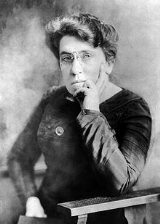
known for her political activism, writing and speeches. She played a pivotal role in the development of anarchist political philosophy in North America
and Europe
in the first half of the twentieth century.
Born in Kovno in the Russian Empire
(present-day Kaunas, Lithuania), Goldman emigrated to the US
in 1885 and lived in New York City
, where she joined the burgeoning anarchist movement.
Crime is naught but misdirected energy. So long as every institution of today, economic, political, social, and moral, conspires to misdirect human energy into wrong channels; so long as most people are out of place doing the things they hate to do, living a life they loathe to live, crime will be inevitable, and all the laws on the statutes can only increase, but never do away with, crime.![]()
The custom of procuring abortions has reached such appalling proportions in America as to be beyond belief... So great is the misery of the working classes that seventeen abortions are committed in every one hundred pregnancies. ![]()
What is patriotism? Is it love of one's birthplace, the place of childhood's recollections and hopes, dreams and aspirations? Is it the place where, in childlike naïveté, we would watch the passing clouds, and wonder why we, too, could not float so swiftly? The place where we would count the milliard glittering stars, terror-stricken lest each one "an eye should be," piercing the very depths of our little souls?
![]()
"Patriotism, sir, is the last resort of scoundrels," said Dr. Samuel Johnson. Leo Tolstoy, the greatest anti-patriot of our time, defines patriotism as the principle that will justify the training of wholesale murderers; a trade that requires better equipment in the exercise of man-killing than the making of such necessities as shoes, clothing, and houses; a trade that guarantees better returns and greater glory than that of the honest workingman.
![]()

